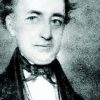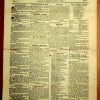When the Street Naming Committee sat to name the streets of Adelaide, Charles Mann, the Advocate General appointed by the South Australian Commission to give legal advice to the Governor and Council in the colony, was missing. In different circumstances he might reasonably have expected to be invited to join this Committee. However, Mann, who was the newly appointed Crown Solicitor and a member of the Executive Council, was on the point of marrying Maria Josepha Brown, sister to John Brown, the Emigration Agent. Unfortunately, Mann’s first wife, Bessie Sheppard, had died prematurely, which goes some of the way to explain why he was prepared to start afresh in South Australia.
As the Committee sat to deliberate on the street names, Mann was presumably preoccupied with the necessary arrangements for his wedding, and being one of the trustees of the newly consecrated Church of Holy Trinity, then under advanced construction in Adelaide, his attention was probably riveted to both the venue and the occasion of his nuptials. Charles and Maria’s wedding took place on 21 June 1837. Theirs was the first licensed marriage at Holy Trinity Church on North Terrace.
It is plausible that James Hurtle Fisher did not consider it circumspect to invite Mann to join the Committee because of the antipathy which had developed between Mann and Governor John Hindmarsh. It was well known by then that Mann had incurred the wrath of Hindmarsh by refusing to come out to South Australia on the HMS Buffalo. Apparently the Governor could not bear the thought that some high-flown obtuse legislation, little understood by the average man, might be conceived in his absence during the time it took to get from London to South Australia. So it had been his wish that Mann be at his side during the voyage to instruct him to draft legislation to his – the Governor’s – advantage and well out of sight of the commissioners.
Mann’s literary talent and thorough knowledge of the law and jurisprudence was enviable. John Brown had already foreshadowed that he thought Hindmarsh was intending to introduce a form of quarterdeck government in the colony, which wasn’t far from the truth. Hindmarsh’s contempt for the views of the commissioners, and especially of Colonel Robert Torrens who he regarded as a distasteful radical, were known to most, even before they departed.
Hindmarsh also knew that Mann had Whig sympathies, which was not unusual, as he was nominally a Whig himself. However, he didn’t fully understand that beneath Mann’s eloquent exterior there dwelt a republican who was totally and utterly committed to the Wakefield dream. Unfortunately, once this became known to the Governor any residual admiration he might have had for Mann soon evaporated. Mann, on the other hand, was too smart for Hindmarsh and sailed instead on the Coromandel, making it perfectly clear to the brusque and pompous Governor where he thought executive power in the colony was vested.
Not quite so much a republican as Brown, Mann’s commitment was to the commissioners and their employees in the colony, and he aligned himself completely with Brown, Robert Gouger, John Morphett and Fisher. His omission from the Street Naming Committee may have even been a diplomatic decision by Fisher, so as not to forewarn the Governor of the pending embarrassment he was about to suffer at the hands of the Committee. Indeed, Mann’s inclusion might have been counterproductive, further infuriating Hindmarsh and jeopardising the sensitive agreement Fisher had struck with the Governor to name the streets by committee.
Charles Mann, whose professional training had been in law and journalism, first appeared at the Adelphi with an interest in the Wakefield plan several weeks after the passage of the South Australia Act in August 1834. The first recorded reference to him is cited by George Morphett (John Morphett’s grandson). He claimed that it was Mann who, on 6 December 1834, proposed a very young John Morphett to be on the committee of the newly formed South Australian Literary and Scientific Association. This body was established by Gouger and others to provide a forum for those intending to emigrate as colonists or who were seeking Commission-sponsored employment in the colony.
Mann needed little persuasion to join the venture and became one of its most outspoken advocates. He fully understood the theory on which it was based, adopted the principles of voluntarism, fervently believed in the separation of church and state, was implacably wedded to the concept of freedom of the press and deeply concerned about widening educational opportunities for the young. Like Lord Henry Brougham and Rowland Hill he was a strong advocate for Mechanics’ Institutes and at one of the earlier public meetings in Adelaide he delivered a comprehensive lecture on that educational phenomenon which was sweeping Britain at the time.
A widower still in his mid-30s and looking for a new start in life, Mann was a competent solicitor of considerable knowledge, a believer in the power of God and someone who held the same philosophy as most of the young aspirants at the Adelphi. His knowledge of the law, personal experience in legal practice and his attention to detail made him a perfect candidate for the position of Advocate General, or Attorney General as it is now more commonly known. At the meeting of the Board of South Australian Commissioners on Wednesday 28 October 1835, Mann was formally appointed to the position, with an annual salary of £300.
Charles Mann was the son of Charles and Sarah Mann (nee Moxon). He was born on 8 July 1799 in the village of Syleham in Suffolk. His grandfather, William Mann, a respected grain merchant, miller and farrier, lived in the same village, where he had a three-storey mill on the banks of the River Waveney, which separates Suffolk from Norfolk.
After what must have been a rigorous education, Charles Mann went into law before being articled to John Sheppard of 9 Dean Street, Southwark. As a result, he met and married his first wife Bessie Sheppard. His skills as a lawyer came under notice and he was admitted to the Bar as a solicitor in the King’s Bench Division and set up practice in Cannon Street, London. In 1828 he was invited to join with a senior partner by the name of Francis Child, who is thought to be from Surrey. Their practice was known as Child and Mann Solicitors.
Both Child and Mann continued to practice together until 1834. They were largely preoccupied with cases which involved real estate and bankruptcy. Given Mann’s religiosity and republican spirit, it was not surprising that he should join with a partner who was known to be a strong religious dissenter and who had more than a passing interest in the Surrey Dispensary. Such philanthropic organisations were usually linked to a parish and were instruments of welfare for the sick and needy. Unfortunately, about the time the scheme was proposed was when Mann’s wife Bessie passed away. Under these or similar circumstances his decision to accept the role of Advocate General and make a new start seemed entirely logical.
Mann arrived in the colony aboard the Coromandel on 12 January 1837. He immediately set up a tent adjacent to some of his friends behind the sandhills at Glenelg. It didn’t take long for the euphoria of the proclamation to pass and for the Governor’s resentment towards Mann to surface.
When Mann’s legal obfuscation and incisive attention to detail became too much for Hindmarsh, Hindmarsh aligned himself with Secretary Stevenson to bring Mann down. Essentially, the Governor’s expectation of being the final arbiter of government decisions was thwarted once too often and he was thrown into disarray. Mann insisted that the final word on legislation always remained with the commissioners, not the Crown, and he supported Fisher unilaterally in this belief.
Within a month of arrival Mann’s position with Hindmarsh was almost irredeemable. From the moment the Governor arrived he sought to overturn Colonel Light’s decision to place the City of Adelaide where it remains today. The Governor wanted it closer to the coast, either at Port Adelaide or Encounter Bay, and on 10 February he instructed Colonial Secretary Gouger to call a public meeting in Edward Stephens’s tent at Glenelg to resolve the issue. It was decided to put the decision to a vote. Mann opened proceedings by moving that:
… those only who in their own right, or in the right of others, hold land orders, or receipts for them, shall be entitled to vote in case of division upon resolutions or amendments moved, and that in the case of a division, the names of persons voting be taken down.
This was a clever strategy designed to block Hindmarsh. Thomas Gilbert seconded the motion and it was carried unanimously. Hindmarsh was clearly after Mann by this time. On 1 November 1837 he wrote to Lord Glenelg proposing to suspend him. Mann had no alternative but to consider his position and at the Council meeting of 13 November he tendered his resignation. It was accepted by Hindmarsh, after which in frustration the Governor dismissed him anyhow!
Once again Mann had outsmarted Hindmarsh. It was not long afterwards that news reached Adelaide that Governor Hindmarsh was to be recalled. While the decision was based on a number of matters, the overriding criticism was that the Governor had tried to undermine the very principles on which the commissioners had based the colony. Governor George Gawler was sent out in his place, but at the same time the position of Resident Commissioner was subsumed within the new Governor’s role. Fisher was suddenly without portfolio and Mann protested through the medium of his new newspaper The Southern Australian.
This broadsheet was introduced in 1838 in opposition to the South Australian Gazette and Colonial Register, which was heavily influenced by George Stevenson, the Clerk of Council, who usually took the Governor’s line. Mann and his friends thought much that was published in the Gazette was both jaundiced and libelous, so he joined with other Philosophical Radicals to provide journalistic balance for the incoming stream of new colonists. A more coherent and dedicated group in support of the principles on which the colony was conceived could not be found.
The editorial in No. 15 of The Southern Australian, which was almost certainly written by Mann, was highly critical of the British Government’s confluence of both the Governor’s role and that of Resident Commissioner. John Brown was reinstated as Emigration Agent and Robert Gouger returned from London with his position vindicated. As far as the commissioners were concerned Gouger’s dismissal was illegal and he resumed as Colonial Secretary, if only briefly, his health then being tenuous at best. Both Fisher and Mann awaited other opportunities in the colony, which were not long in coming, and the battle between the two newspapers continued unabated.
In Adelaide, Mann decided to join E.C. Gwynne in private practice as a lawyer where his services were keenly sought by many, including the South Australian Company.
The question should now be asked: who was Charles Mann? There is plenty of evidence to show he was a learned man with a fine eye for detail and careful argument. Even some of his enemies respected his knowledge of the law.
He was clearly a committed Christian and a practising Anglican. On arrival in Adelaide he became a trustee of Holy Trinity. As Secretary of the South Australian Church Society he held the proxy vote for the ‘town acre’ on which the church now stands. He was also a considerable biblical scholar. As time progressed in the colony Mann’s religious position altered somewhat and he came to prefer the Congregational ministry of Thomas Quinton Stow. A speculative explanation for this might have been the fact that both his wife and brother-in-law, John Brown, were strong Congregationalists and that there was a more strident call for voluntarism among Stow’s followers and a clearer demarcation between church and state. The ‘Independents’, as they were called, could not abide any talk of state aid to religion and were generally in favour of the introduction of responsible government.
Charles and Maria settled to married life in a new house, which Mann had built on his acre in Brown Street (now part of Morphett Street). By 1844 he also had a run on the River Torrens, where he grazed 1,700 ewes and 300 wethers. Mann named the property Syleham, after the village of his birth, and for a time he was one of the bigger landholders of the day.
Mann went on to have a fruitful life in Adelaide and his achievements over the next quarter of a century were considerable. Beyond being the first Advocate General and the first Solicitor General in Adelaide, he was also a member of the first council of the City of Adelaide during Fisher’s mayoralty. He was also at times a Justice of the Peace, a Special Magistrate, Commissioner of the Court of Insolvency, and Acting Justice of the Supreme Court (1849). He was an inaugural member of the South Australian Club, a committee member of the South Australian Literary and Scientific Association, the Mechanics’ Institute and the Subscription Library. The Southern Australian,of which he was editor, lasted several years.
Mann married four times in all. Following his second marriage to Maria Brown who bore him Charles Jnr, his other two wives in succession were Mary Cook and Ann Malpas.
Charles Mann’s contribution to social and political change in Adelaide is not as well documented as that of some of his contemporaries because as part of the judiciary he could not be seen to take public positions on many of the issues of the day. Nevertheless, it is believed that from behind the screen of the judiciary he was in fact one of the more influential figures of his time in the province.
He died on 24 May 1860 and was buried at West Terrace Cemetery on 26 Saturday May, after a private service. His name is perpetuated in Mann Terrace, North Adelaide, and the Mann Ranges in the far north of the state of South Australia.







Comments